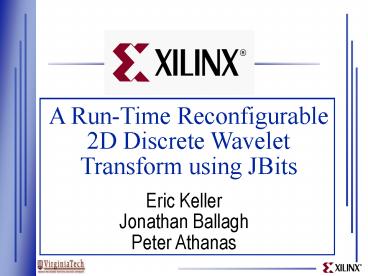Xilinx Color Overhead template - PowerPoint PPT Presentation
Title:
Xilinx Color Overhead template
Description:
Certain wavelets are more effective for different applications ... ASICs are fast, but are limited in terms of parameterization. Wavelet Selection. Medium ... – PowerPoint PPT presentation
Number of Views:119
Avg rating:3.0/5.0
Title: Xilinx Color Overhead template
1
A Run-Time Reconfigurable 2D Discrete Wavelet
Transform using JBits
Eric Keller Jonathan Ballagh Peter Athanas
2
Topics
- Motivation
- DWT Background
- Design Overview
- Interfacing
- Results
- Future Work/Conclusions
3
Motivation
- Previous ASIC/FPGA DWT implementations were
static - Wavelet coefficients are fixed
- Certain wavelets are more effective for different
applications - Currently, JPEG2000 uses a lossy and
loss-less wavelet - Will eventually allow for more wavelets
- Software provides a great deal of flexibility,
but is too slow - ASICs are fast, but are limited in terms of
parameterization
SORT OF
4
The JBits Environment
RTP Core Library
JBits API
User Code
JRoute API
Remote Hardware
BoardScope Debugger
XHWIF
TCP/IP
FPGA Hardware
Device Simulator
5
The 2-D DWT
- Multiresolutional decomposition of a signal
- Represents the signal in the time-scale domain
- More efficient than the DCT
- Used in JPEG2000
- Low-pass filter extracts average coefficients
- High-pass filter extracts detail coefficients
TRANSFORM OUTPUT
ROWS
COLS
IMAGE
6
Core Hierarchy
ShiftRegister
Comparator
LUT4
Address Generators
Constant
Register
MUX2_1
Counter
MUX2_1
DWT2D
AdderTree
Register
MUX2_1
KCM
DistributedROM
16x1ROM
FIRFilter
Adder
AdderTree
Register
Register
7
DWT2D Core
- Fully parameterizable
- Filter length and coefficients
- Image height and width
- Coefficient precision
- Based on the folded-architecture
- Filter bank latency is balanced with registers
- MUX cores select filter input source, filter
output, memory addresses and data
OUTPUT
INPUT
MEMORY 1
MEMORY 2
MUX
MUX
MEMORY ADDRRESS GENERATOR 1
MEMORY ADDRESS GENERATOR 2
MUX
HP FIR FILTER
MUX
LP FIR FILTER
Z-1
8
Address Generators
- Separate input and output address generators
cores - Zero-padding on edges
- Generates addresses for SRAM memories
- Difficult without behavioral synthesis
- Same circuitry is used to perform row and column
scans - Output address generator reverses row and column
address values
9
DWT2D NCD View
- Generated using XDL RTP core output
- Features a 9/7-tap 12-bit filter-bank
configuration - Address generators are located near their
respective SRAM IOBs - IOB interfacing is not shown
10
Interfacing
- DWT2D requires two external SRAMs
- Slaac1V X2 XCV1000 was the target FPGA
- JBits RTR I/O classes were used for core
interfacing - Provide automated IOB configuration/interfacing
using a RTR core interface - Eliminated reliance on external tool flows
- Created SRAM RTP core to abstract SRAM hardware
11
Results Transform Output
- 3-Levels of Decomposition
- Daubechiess N3 Orthogonal Wavelet Filters
12
Results DWT2D Performance
- Timing results were computed on 1 GHz Pentium III
with 1 GB of RAM running Windows2000
13
Results FIR Filter Performance
14
Results - Partial Reconfiguration
- Reconfiguration times are still too lengthy!
- In most cases, only the filters are dynamic
- Use existing DWT2D bitstream
- Leave FIR filter circuitry in place
- Use constant-folding to modify LUTs
- Use JRTR to keep track of bitstream changes
- Write only modified portion of bitstream
15
Results Partial Reconfiguration
- Full XCV1000 bitstream size is 766K bytes
16
Future Work
- Use a more efficient architecture (non-folded)
- Recursive Pyramid Algorithm
- Uses a systolic-parallel architecture
- Transform period of N2 cycles/level
- Requires less memory
- Use on-chip BRAM to store intermediate results
- Reduce critical path delay
- Bring DWT speed up to filter speeds
- Add row-extension support
- Symmetric reflection
- Integrate core into a compression system
- Add quantizer and entropy encoder cores
17
Conclusions
- Designed a RTR/RTP 2-D DWT core using JBits
- Also created several smaller cores for the DWT
core library - FIR Filter / Adder Tree / KCM / Adder /
Comparator - No reliance on traditional vendor tools
- Generated completely from a XCV1000 NULL
bitstream - Implemented an RTR I/O interfacing methodology
- Used RTR I/O classes to connect the DWT2D core to
the Slaac1V SRAMs - Showed that reasonable DWT2D reconfiguration
times are achievable with partial reconfiguration































